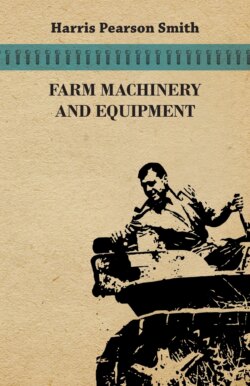Читать книгу Farm Machinery and Equipment - Harris Pearson Smith - Страница 24
На сайте Литреса книга снята с продажи.
CHAPTER 5 LUBRICANTS AND LUBRICATION
ОглавлениеProbably the chief cause for machinery wearing out is improper and insufficient lubrication. Much of this trouble can be traced to the negligence of the operator, the poor construction of bearings, and the failure to provide adequate means of conducting the lubricant to the bearing units. Lubrication is needed because of friction.
Friction. Friction is that force which acts between two bodies at their surface of contact so as to resist the sliding of one body on another. When one object is being dragged along upon another object, friction between the two tends to stop the one that is being dragged. When one surface rests upon another, there is a tendency for the inequalities of the one to fit into those of the other, causing an interlocking not unlike that produced by putting the cutting edges of two saws together. If such interlocking has occurred, it is possible to move one body over the other only by separating them or by tearing off the interlocking surfaces. No matter how smooth surfaces may be, there are still some elevations and depressions remaining which will permit a small degree of interlocking.
Rolling Friction. When one body rolls upon another, the friction is much less than when one body slids upon another. The resistance in this case is called the rolling resistance or friction. This can readily be demonstrated by attempting to carry as much upon a sled which has no wheels as upon a wagon or other vehicle mounted on wheels. Many farm implements are now using some type of antifriction bearing in the form of balls or rollers to diminish the amount of friction, which materially increases the efficiency of the machine. Friction in moving parts of machinery causes wasted energy and it is, therefore, desirable to reduce it to the smallest possible amount. However, in clutches, or to prevent slippage of belts on pulleys, friction is necessary and useful.
Lubrication as a Remedy for Friction. Lubrication tends to reduce friction. The theory of the action of lubrication is that a thin film of the lubricant adheres to the bearing and another to the shaft, completely separating the metal surfaces. Then, these films slip one on the other, which reduces the amount of friction. This is because the friction between the films of lubricants is much less than that between the metal parts. A lubricant may act in different ways in reducing the amount of friction: first, by changing the greater resistance of metal to metal to the relatively small resistance of oil over oil; second, by filling up the small depressions in the two frictional surfaces and in this way preventing the so-called interlocking (Fig. 5–1).
Forms of Lubricants. Lubricants are available in three forms: fluid oils, semisolids, and solids. Fluid oils are those that flow freely, such as gas-engine cylinder oils and oils used for lubricating various bearings by means of oil holes or oil cups. Semisolids include the soft greases, such as transmission and differential grease. Solid lubricants consist of graphite and mica. Of these forms, soft greases and oils are most generally used to lubricate farm implements.
FIG. 5–1. How a lubricant keeps two pieces of metal apart. (John Deere.)
Kinds and Sources of Lubricants. All lubricants have three general sources: animal, vegetable, and mineral. Animal oils are lard, tallow, and fish oils. Vegetable oils are cottonseed oil, castor oil, olive oil, and linseed oil. Mineral oils are oils obtained by refining crude petroleum. Of all these, mineral oils are the most universally used on the farm, because they can withstand higher temperatures without breaking down.
Manufacture of Lubricants. The diagram in Fig. 5–2 shows the steps in the refining process and the points of extraction where fuels, light, medium, and heavy oils, and the extra-heavy lube stock are obtained.
